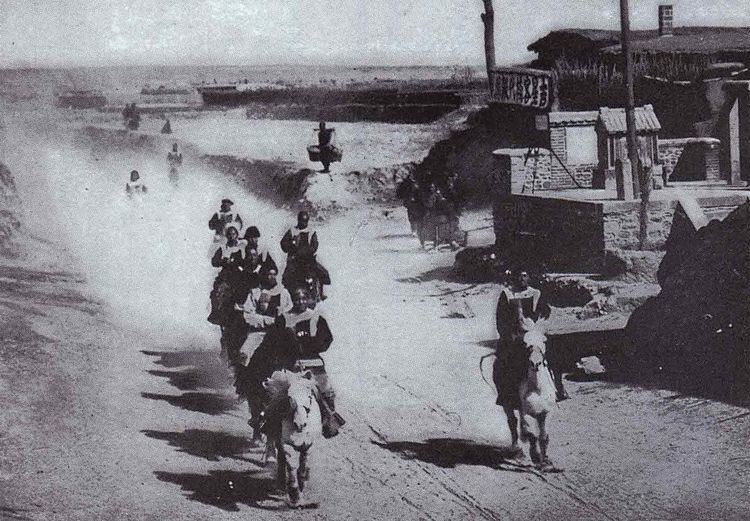 | ||
Honghuzi (Chinese: 红胡子; literally: "Red Beards") were armed Chinese robbers and bandits in the areas of the eastern Russia-China borderland, comprising southeastern Siberia, the Russian Far East, and Northeast China (then known as Manchuria). The word has been variously transliterated as hong huzi, hong hu zi, hunghutze, hun-hutze, etc. There is also a common transliteration from Russian, khunkhuzy, and a back-formation for the singular, khunkhuz.
Contents
Resistance to foreign occupation
Near the end the 19th century the honghuzi harassed Russian efforts to build the Manchurian Railway and in general plagued the Russian troops in Manchuria. The Honghuzi participated in the Boxer Rebellion against the Eight-Nation Alliance, and after the Russian invasion of Manchuria carried on guerrilla warfare against the Russian occupation. The origin of most Honghuzi was China proper. Many Honghuzi were former Chinese soldiers or unemployed laborers.
Boxer Rebellion
Louis Livingston Seaman wrote about an incident in which the Honghuzi, who were also Boxers, ambushed, tortured and executed an Eight-Nation Alliance force consisting of Sikhs:
The Honghuzi also participated in the battle of Blagoveshchensk, where the Russians carried out a massacre of Chinese civilians.
Resistance to the Russian Empire
Many parts of the country were infested by the Honghuzi.
The term Hong huzi itself may have originally been applied during the 1600s to the Russians by the Chinese, since it meant "red bearded". Indigenous peoples of Amur were attacked by these Russian red beards, but the name was later changed to apply to Chinese bandits only.
Honghuzi raided Russian settlers in the Far East region during the nineteenth and twentieth centuries. In one incident, the Honghuzi attacked the Heeck family, kidnapping Fridolf Heeck's son and killing his servant and wife in 1879.
The war-correspondent Douglas Story mentioned an incident where one Honghuzi killed several Russian Cossacks before succumbing to return fire: "I have seen a solitary Hunghutze, pursued by a Cossack patrol, calmly dismount from his pony and engage an entire sotnia with his solitary rifle. Kneeling in a field of kiaolang stubble, alone and unsupported, he deliberately picked off the men with his Mauser until the Russians pulled themselves sufficiently together to end his sharp-shooting with a volley."
During the Russo-Japanese War, the Honghuzi took advantage of the conflict to carry out attacks against Russian forces:
There was also at the end of February a report that a land mine had exploded at the Russian station at Hayuenkow, on the south coast of Liaotung, between the Yalu and Port Arthur. The Russians had expected the Japanese would try to land here, as it was one of their principal landing-places in the war of 1894 against China; so the place was mined, and it was said that the Hunghutze attacked the Russians in force, and managed to blow up the mine, with a loss of 200 Russian soldiers. There were numerous other outbreaks of the Hunghutze, who seem to have carried on a sort of guerrilla warfare against the Russians all the time.
Dr. Seaman observed the Chinese Honghuzi in action against the Russians during the war, as described in The Nation magazine: "He had some amusing and exciting experiences with the Hung-hutzes (Chun-chuzes), ex-bandits, now nominally Chinese soldiery, many of whom were operating as guerrillas on the Russian flank and communications under Japanese officers, as is charged." The Japanese had in their employ Zhang Zuolin (Chang Tso-lin), a famous Honghuzi leader who led his men against the Russians.
One Russian position was swarmed by around 500 Honghuzi. Russian casualties reached 20 wounded and dead before the Honghuzi were driven away.
The Chinese Imperial troops let the Honghuzi roam freely, since many of them used to be comrades, as described by Dr. Seaman: "They can not be caught, the plain truth being that the best of fellowship exists between them and the imperial troops, their old comrades of yore." Seaman also mentioned the reason for the Honghuzi hatred towards the Russians:
The Chinaman, be he Hung-hutze or peasant, in his relation to the Russians in this conflict with Japan has not forgotten the terrible treatment accorded him since the Muscovite occupation of Manchuria. He still remembers the massacre at Blagovestchensk when nearly 8,000 unarmed men, women, and children were driven at the point of the bayonet into the raging Amur, until—as one of the Russian officers who participated in that brutal murder told me at Chin-Wang-Tao in 1900— 'the execution of my orders made me almost sick, for it seemed as though I could have walked across the river on the bodies of the floating dead.' Not a Chinaman escaped, except forty who were employed by a leading foreign merchant who ransomed their lives at a thousand rubles each. These, and many even worse, atrocities are remembered and now is their moment for revenge. So it was easy for Japan to enlist the sympathy of these men, especially when emphasized by liberal pay, as is now the case. It is believed that more than 10,000 of these bandits, divided into companies of from 200 to 300 each and led by Japanese officers, are now in the pay of Japan.
Zhang Zuolin's forces
Zhang Zuolin (Chung Tsor Lin) commanded a large army of Honghuzi, who were allied to the Japanese during the war. Louis Livingston Seaman wrote an account of his meeting with Zhang and his army:
Attacks on Japanese
Some Honghuzi also attacked Japanese forces in Manchuria. A Japanese officer told Fred Arthur McKenzie that "Sometimes the robbers come and fire shots into our houses at night time. If we did not make thick earthen ramparts around, we would be killed."
Other conflicts
In 1937 the honghuzi were recruited to fight alongside republican forces in Northeast China.
